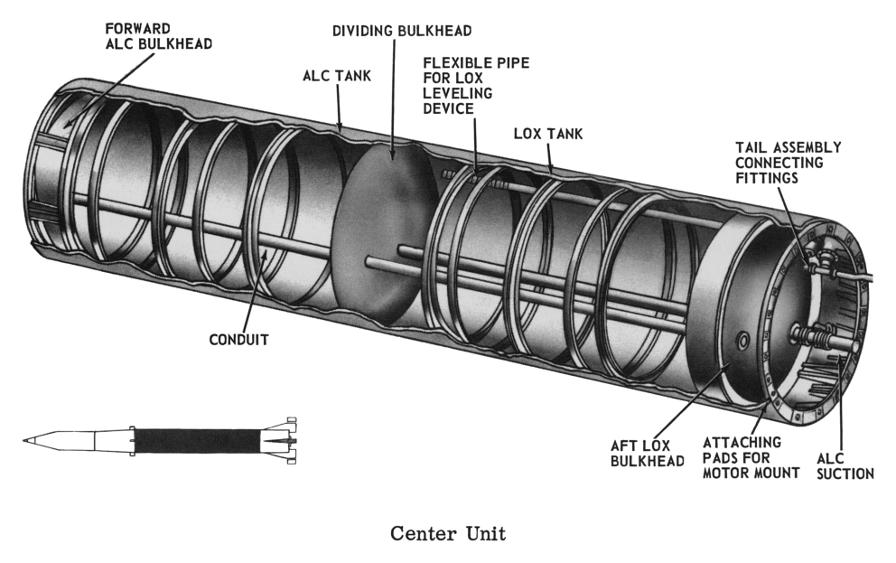Redstone Missile Center Unit (Propellant Tanks)
The largest component of a Redstone missile is the center unit, which contains the alcohol and liquid oxygen tanks and to which the A-7 rocket engine mounts.
Click image for a 3969x2492 pixel version of this image in a new window.
Adapted from p. II-7 of This is Redstone, located in the Dunaway
collection, Dept. of
Archives/Special Collections, M. Louis Salmon Library, University of
Alabama in Huntsville. Available in electronic format from My Army
Redstone Missile Days
Scan, cleanup, and adaptation by heroicrelics.
Callouts in this diagram include
- Forward alcohol bulkhead
- Conduit
- Alcohol tank
- Dividing bulkhead
- Flexible pipe for LOX leveling device
- LOX tank
- Aft LOX bulkhead
- Attaching pads for motor mount
- Tail assembly connecting fittings
- Alcohol suction
The center unit is forward of the tail unit and aft of the aft unit (the latter being confusingly named, as it is forward of the center unit). It is 5 feet 10 inches (70 inches) in diameter and, along with the tail unit, is 41 feet 4 inches in length. (Those familiar with the Saturn I and IB rockets will recognize the 70-inch diameter tank as one of the eight outer tanks on the first stages of those rockets.) As it was not designed to survive re-entry, the center unit is fabricated of lightweight aluminum.
The center unit contained all of the plumbing for the propellant tanks. There were external fittings for a LOX vent and for LOX and alcohol fill/drain lines. The alcohol tank, located at the forward end of the center unit, was serviced via a duct which traversed the LOX tank and ended at the dividing bulkhead separating the tank compartments (the term common bulkhead didn't seem to be used at this early date). The LOX vent line ran up the LOX tank wall, terminating just before the dividing bulkhead. The LOX fill/drain line was simply attached to the aft LOX bulkhead. A conduit also ran through both tanks to carry the general cable harness and pneumatic lines that connected the pneumatic and electrical components located forward of the tanks to those located in the tail unit.
The forward frame ring of the center unit had six sockets that received ball fittings on the aft unit to align the two components and fastened the aft unit to the center unit. Explosive screw access doors in line with each socket allowed the installation of the explosive screws from outside the missile; the thrust unit (the center unit plus the tail unit) was jettisonned after engine burn-out.
The forward end of the center unit also had four vane lock rod assemblies which extended forward from the center section to join the four air vane lock rods in the aft unit. The vane lock rods held the aft unit's air vanes in a fixed position until separation of the missile in flight. At separation, the vane lock rods were pulled from the four actuators in the aft unit and the air vanes were left free to operate.
The aft ring frame had four steel pads to which the engine mount was bolted and 20 connecting brackets which fastened the center unit to the tail unit.
Much of the descriptive text on this page was taken from This is Redstone.

